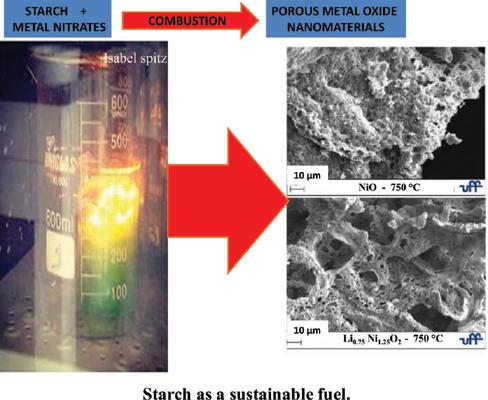Current Nanoscience ( IF 1.4 ) Pub Date : 2021-06-30 , DOI: 10.2174/1573413716999201106150041 Francisco Manoel dos Santos Garrido 1 , Maria Isabel Spitz Argolo 1 , Marta Eloísa Medeiros 1 , José Márcio Siqueira 2

|
Background: Currently, solution combustion synthesis (SCS) is considered a reproducible, flexible, and low-cost synthesis method for the preparation of nanomaterials. A new trend in the SCS method is the use of less polluting fuels, such as starch. The use of starch as fuel in SCS is very interesting for green chemistry, as it is renewable and has several advantages, including its abundance, low-cost, and non-toxicity.
Objective: This paper provides a comprehensive review of the SCS method using starch as fuel. The main advantages of using starch as fuel will be illustrated with a wide variety of examples, highlighting its impact on the preparation of nanomaterials for energy and environmental applications.
Conclusion: In a combustion reaction using starch as fuel, several positive effects are expected, such as non-violent propagation, combustion with the production of non-toxic gases (mainly CO2 and H2O), and development of pores during the release of gases. For example, several macroporous metal oxide foams were prepared using the SCS method, through an appropriate combination of urea and starch fuels. With this approach, it is possible to control the structure, lattice defects, crystallite size, specific surface area, porosity, and other characteristics of the synthetized nanomaterial. For example, by combining starch with other fuels, it is possible to control the concentration of lattice defects in metal oxides and modify the optical properties of these materials. These properties are of fundamental importance for the performance of these materials and their subsequent application in electrodes, electrocatalysts, and photocatalysts in the areas of energy and environment.
中文翻译:

淀粉作为溶液燃烧合成的可持续燃料:用于能源和环境应用的纳米材料
背景:目前,溶液燃烧合成(SCS)被认为是一种可重复、灵活且低成本的纳米材料制备合成方法。SCS 方法的一个新趋势是使用污染较少的燃料,例如淀粉。在 SCS 中使用淀粉作为燃料对于绿色化学非常有趣,因为它是可再生的,并且具有多种优势,包括其丰富、低成本和无毒。
目的:本文全面回顾了以淀粉为燃料的 SCS 方法。将通过各种示例说明使用淀粉作为燃料的主要优势,强调其对制备用于能源和环境应用的纳米材料的影响。
结论:在使用淀粉作为燃料的燃烧反应中,预计会有一些积极的影响,例如非暴力传播,燃烧产生无毒气体(主要是 CO 2和 H 2O),以及在气体释放过程中孔隙的发展。例如,通过尿素和淀粉燃料的适当组合,使用 SCS 方法制备了几种大孔金属氧化物泡沫。通过这种方法,可以控制合成纳米材料的结构、晶格缺陷、微晶尺寸、比表面积、孔隙率和其他特性。例如,通过将淀粉与其他燃料结合,可以控制金属氧化物中晶格缺陷的浓度并改变这些材料的光学特性。这些特性对于这些材料的性能及其随后在能源和环境领域的电极、电催化剂和光催化剂中的应用至关重要。











































 京公网安备 11010802027423号
京公网安备 11010802027423号